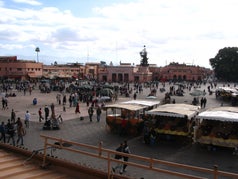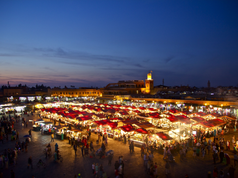Bahja by Marrakesh
…. or Land of happiness. Marrakesh (or 'Marrakech', the French spelling) is like a scene from the famous ‘Thousand and One Nights-fairy tale’. The city is also called the “red city” because of the buildings and ramparts made of beaten clay, founded in 1070-1072. Marrakesh is the cultural capital of Morocco. The many sights, including the historic Medina and palaces to busy bazaars and alleys, have given the city this name. We love the cultural diversity of Marrakech with its melting pot of Arabic, Berber, European and African influences.



There are three main languages spoken in Marrakesh (and all of Morocco) – Arabic, French, and Amazigh. During the early 20th century, the French occupied Morocco and for that reason, many Moroccan locals still converse in French today. Amazigh is a group of the lesser-known set of languages spoken by the Berber people of Morocco.
We spent 3 nights in Marrakesh and did mainly everything on foot (and sometimes, we took a taxi). One day we booked this tour with a local guide: 'Marrakesh Monuments & Souks 3-hour tour', and it was definitely worth it.
Our highlights
- Jemaa el-Fnaa (central square)
- Streets and souks of Medina (yellow area)
- Bahia Palace
- Koutoubia Mosque
- Cimetière Juif de Miaara
- Traditional tajine food
- Jardin Majorelle
- Our stay at Riad Des Deux Mers

1. Jemaa el-Fnaa
The heart of the medina is Jemaa el-Fnaa square, a vibrant marketplace. With the smells of the tastiest Moroccan spices, the buzz of the terraces and the sounds of the street musicians, we can spend hours here. Jemaa el-Fnaa is a real attraction, especially in the evening, because then this square comes completely to life.




If you are visiting Marrakesh with children, the ideal time to visit the square is probably the end of the afternoon, when it comes alive with live musicians, water carriers, monkey trainers and especially snake charmers.
Family tip:
For only a few euros, kids can get a pretty henna tattoo, an original little souvenir to bring back from Marrakesh!
2. Streets of Medina
The Medina is the older and central part of the city, surrounded by old city walls. A buzzing area full of history and culture, in which you can get easily lost (see this as a part of the experience). Behind the cozy cafes and restaurants at the Jemaa el-Fnaa Square are the souks of Marrakesh, narrow streets with colorful stalls on both sides of the street displaying fragrant herbs, beautiful pottery, carpets and the most beautiful souvenirs. The medina of Marrakesh is a UNESCO World Heritage Site.








3. Bahia Palace
Bahia palace was built in 1859 by order of Minister Ahmed bin Musa. It was important to bring back the Islamic and Moroccan communities in this palace. The name Bahia means shine, and this is also reflected in all the beautiful rooms. There is a large square in the palace where you can take beautiful photos and have a beautiful view.

4. Koutoubia Mosque in Kasbah Quartier
The Koutoubia Mosque is not to be missed when visiting Marrakesh. From the Jemaa el-Fnaa Square, you can look out at the 77-meter-high minaret of the Koutoubia Mosque that towers above the city. This mosque dates from the 12th century. As a non-Muslim, we are unfortunately not allowed to enter the mosque and admire the inside, but the surrounding area is certainly worth exploring.




Family fun tip: take a carriage ride and go around the ramparts of the Marrakesh Medina or even to the Majorelle Garden.

5. Cimetière Juif de Miaara
Cimetière Juif de Miaara, located south of the city, is the Jewish cemetery of the city of Marrakesh. It is the largest Jewish cemetery in the country. It is a beautiful, serene place.
6. Traditional tajine food
All the cultural diversity of the Arab, Berber, European and African peoples can be found in Moroccan cuisine, which gives it such a characteristic taste. A lot of cooking is done with tajine, a traditional cookware that authentically prepares the taste of Berber cuisine.

In such a dish, meat goes perfectly with sun-drenched vegetables and fruit. For example a lamb tajine with apricots or a tajine with chicken and lemon.
Flavors that are typical in Moroccan cuisine: cumin, paprika, garlic, salt, pepper, ginger, cinnamon, coriander, saffron, turmeric, sesame seeds, fresh parsley, cilantro, harissa (red-chili-and-garlic paste), olive oil, and olives.
As a desert, sweet mint tea with the famous oriental pastries is delicious.
Tip: drink delicious mint tea at Café Restaurant Hotel De France (72 Rue des Banques).
If you sit outside on the 2nd floor, you can enjoy a fantastic view of the square, with the Koutoubia Mosque in the background, for free.

7. Jardin Majorelle

Just outside the old center, located northwest of Marrakesh, the city has a beautiful botanical garden designed by the French artist Jacques Majorelle. Famous for its particular blue color and the bright yellow, the villa is surrounded by a splendid botanical garden, with plants from all over the world: cacti, bamboo, water lilies, jasmines…. The Majorelle Garden was owned by the well-known French fashion designer Yves Saint Laurent from 1980. After his death in 2008, his partner threw the ashes over the rose garden.
8. Riad-stay
Seriously... what is this place! Our stay in the Riad Des Deux Mers, a traditional Moroccan house, was unforgettable. We felt like we could experience the real, authentic Moroccan way of life here. The riads of Marrakesh are located within the old city walls “Medina”. Our stylish riad dated from the 19th century and was just a 5-minute walk from Jemaa el-Fnaa Square and the Koutoubia Mosque. Through one of the busy, narrow streets and a heavy wooden door, we entered an oasis of peace. Our riad combined Moroccan, Andalusian, Berber-Arab and French architecture. Built in a square consisting of 2 floors with hotel rooms in the outer ring overlooking the central part; a patio where we could read, relax, drink tea, etc. What an enjoyable place.








Photo album Marrakesh
This blog may contain affiliate links, meaning we get a commission if you decide to purchase something through the links, at no additional cost to you. Read our affiliate discloser here.















